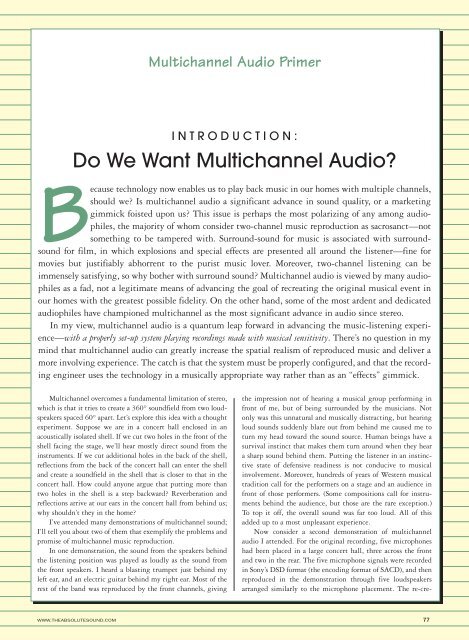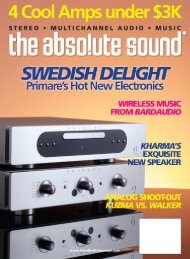Absolute Sound
Absolute Sound
Absolute Sound
You also want an ePaper? Increase the reach of your titles
YUMPU automatically turns print PDFs into web optimized ePapers that Google loves.
Multichannel overcomes a fundamental limitation of stereo,<br />
which is that it tries to create a 360° soundfield from two loudspeakers<br />
spaced 60° apart. Let’s explore this idea with a thought<br />
experiment. Suppose we are in a concert hall enclosed in an<br />
acoustically isolated shell. If we cut two holes in the front of the<br />
shell facing the stage, we’ll hear mostly direct sound from the<br />
instruments. If we cut additional holes in the back of the shell,<br />
reflections from the back of the concert hall can enter the shell<br />
and create a soundfield in the shell that is closer to that in the<br />
concert hall. How could anyone argue that putting more than<br />
two holes in the shell is a step backward? Reverberation and<br />
reflections arrive at our ears in the concert hall from behind us;<br />
why shouldn’t they in the home?<br />
I’ve attended many demonstrations of multichannel sound;<br />
I’ll tell you about two of them that exemplify the problems and<br />
promise of multichannel music reproduction.<br />
In one demonstration, the sound from the speakers behind<br />
the listening position was played as loudly as the sound from<br />
the front speakers. I heard a blasting trumpet just behind my<br />
left ear, and an electric guitar behind my right ear. Most of the<br />
rest of the band was reproduced by the front channels, giving<br />
Multichannel Audio Primer<br />
INTRODUCTION:<br />
Do We Want Multichannel Audio?<br />
Because technology now enables us to play back music in our homes with multiple channels,<br />
should we? Is multichannel audio a significant advance in sound quality, or a marketing<br />
gimmick foisted upon us? This issue is perhaps the most polarizing of any among audiophiles,<br />
the majority of whom consider two-channel music reproduction as sacrosanct—not<br />
something to be tampered with. Surround-sound for music is associated with surroundsound<br />
for film, in which explosions and special effects are presented all around the listener—fine for<br />
movies but justifiably abhorrent to the purist music lover. Moreover, two-channel listening can be<br />
immensely satisfying, so why bother with surround sound? Multichannel audio is viewed by many audiophiles<br />
as a fad, not a legitimate means of advancing the goal of recreating the original musical event in<br />
our homes with the greatest possible fidelity. On the other hand, some of the most ardent and dedicated<br />
audiophiles have championed multichannel as the most significant advance in audio since stereo.<br />
In my view, multichannel audio is a quantum leap forward in advancing the music-listening experience—with<br />
a properly set-up system playing recordings made with musical sensitivity. There’s no question in my<br />
mind that multichannel audio can greatly increase the spatial realism of reproduced music and deliver a<br />
more involving experience. The catch is that the system must be properly configured, and that the recording<br />
engineer uses the technology in a musically appropriate way rather than as an “effects” gimmick.<br />
the impression not of hearing a musical group performing in<br />
front of me, but of being surrounded by the musicians. Not<br />
only was this unnatural and musically distracting, but hearing<br />
loud sounds suddenly blare out from behind me caused me to<br />
turn my head toward the sound source. Human beings have a<br />
survival instinct that makes them turn around when they hear<br />
a sharp sound behind them. Putting the listener in an instinctive<br />
state of defensive readiness is not conducive to musical<br />
involvement. Moreover, hundreds of years of Western musical<br />
tradition call for the performers on a stage and an audience in<br />
front of those performers. (Some compositions call for instruments<br />
behind the audience, but those are the rare exception.)<br />
To top it off, the overall sound was far too loud. All of this<br />
added up to a most unpleasant experience.<br />
Now consider a second demonstration of multichannel<br />
audio I attended. For the original recording, five microphones<br />
had been placed in a large concert hall, three across the front<br />
and two in the rear. The five microphone signals were recorded<br />
in Sony’s DSD format (the encoding format of SACD), and then<br />
reproduced in the demonstration through five loudspeakers<br />
arranged similarly to the microphone placement. The re-cre-<br />
WWW.THEABSOLUTESOUND.COM 77










